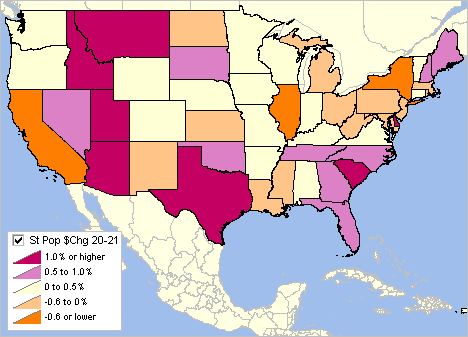

|
|
-- 7/1/20 & 7/1/21 -- post Census 2020 population estimates -- expanding insights through data analytics December 2021 .. there were approximately 1,000 births per day in Texas in 2021 (an annual average). The number of new people arriving in Texas (births plus net migration) was approximately 1,500 per day in 2021. And in California, where there are 1,160 births per day .. the births plus net migration estimate is approximately 200 per day (the impact of out net migration). Eighteen states experienced a decrease in total population over the year. How do states of interest compare? See the interactive table below. The U.S. population grew by 392,665, or 0.1%, in the past year, the lowest rate since the nation's founding. These data are based on Census Bureau post-Census 2020 estimates released in December 2021. The slow rate of growth is due to decreased net international migration, decreased fertility and increased mortality due in part to the pandemic. These data are integrated into updated ProximityOne 2060 projections. This section provides data and tools to access and use the latest population estimates and components of change. Use the interactive table below to view, rank, compare the estimates and components of change. See related State-County Population 2010-2020. How State Population is Changing, 7/1/20-7/1/21 The following graphic shows patterns of population percent change by state from 7/1/20 to 7/1/21. The color patterns/intervals are shown in the inset legend. In the larger view (click graphic), states are labeled with 7/1/20-7/1/21 percent change. Click graphic for larger view. Expand browser to full window for best quality view.  .. view developed using the CV XE GIS software. .. view using the VDA Web GIS .. nothing to install; requires only a browser; device independent; use any browser. .. click map for larger view and details. Interactive Table.. goto top Use the table below , for example, to see that between 7/1/2020 and 7/1/2021, the U.S. growth was due to natural increase (148,043 .. the number of births over deaths) and net international migration (244,622). This is the first time that net international migration (the difference between the number of people moving into the country and out of the country) has exceeded natural increase for a given year. Use the table to compare how states of interest rank and are changing. U.S. & State Population & Components of Change: 2020-2021 .. interactive table .. goto top Use mouse-over on header column to view extended item/column name. Click ShowAll button between queries. See usage notes below table. Related ranking tables: interactive tables. Usage Notes Use mouse-over on header column to view extended item/column name. Click ShowAll button to reset table. Column Descriptions .. goto top
- Area Name
- USPS State abbreviation - Population 7/1/20 - Population 7/1/21 - Population Change 2020-21 - Population %Change 2020-21 - Births 2020-21 - Deaths 2020-21 - Natural Increase 2020-21 - Intl Migration 2020-21 - Domestic Migration 2020-21 - Net Migration 2020-21 - Residual 7/1/20-6/30/21 - Birth rate - Death rate 7/1/20-6/30/21 - Nat Inc rate 7/1/20-6/30/21 - Intl Mig rate 7/1/20-6/30/21 - Dom Mig rate 7/1/20-6/30/21 - Net Mig rate 7/1/20-6/30/21 - , Population Components of Change go to top The population in period t (P[t]) for an area is defined using the identity: P[t]:=P[t-1]+B[t]-D[t]+IM[t]+DM[t], where: - P[t] -- resident population as of 7/1/t - P[t-1] -- resident population as of 7/1/t - B[t] -- births during the period 6/30/t-1 to 7/1/t - D[t] -- deaths during the period 6/30/t-1 to 7/1/t - IM[t] -- international migration during the period 6/30/t-1 to 7/1/t - DM[t] -- domestic during the period 6/30/t-1 to 7/1/t B, D, IM and DM are the components of change. Related Sections .. goto top • State Trends • State of the States • Situation & Outlook Estimates & Projections • State GDP - annual, longer term, this section • State GDP - quarterly • Metro GDP - annual, per capita real GDP • Metro GDP by Industry - annual, real GDP, GDP, indexes • Metro GDP by Industry - quarterly; real GDP, GDP, indexes; integrated U.S., state, metro (MSA) • Regional Economic Information System - annual, personal income by major source, employment by sector • State & Regional Income & Products Accounts Support Using these Resources .. goto top Learn more about demographic economic data and related analytical tools. Join us in a Data Analytics Lab session. There is no fee for these Web sessions. Each informal session is focused on a specific topic. The open structure also provides for Q&A and discussion of application issues of interest to participants. ProximityOne User Group Join the ProximityOne User Group to keep up-to-date with new developments relating to geographic-demographic-economic decision-making information resources. Receive updates and access to tools and resources available only to members. Use this form to join the User Group. Additional Information ProximityOne develops geographic-demographic-economic data and analytical tools and helps organizations knit together and use diverse data in a decision-making and analytical framework. We develop custom demographic/economic estimates and projections, develop geographic and geocoded address files, and assist with impact and geospatial analyses. Wide-ranging organizations use our software, data and methodologies to analyze their own data integrated with other data. Follow ProximityOne on Twitter at www.twitter.com/proximityone. Contact ProximityOne (888-364-7656) with questions about data covered in this section or to discuss custom estimates, projections or analyses for your areas of interest. |
|
|